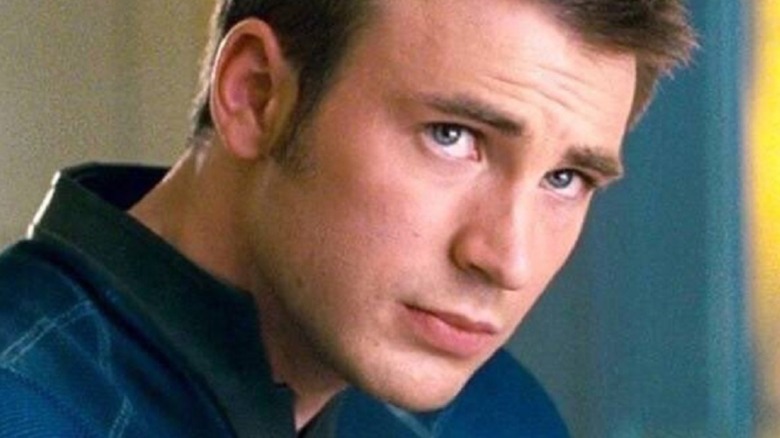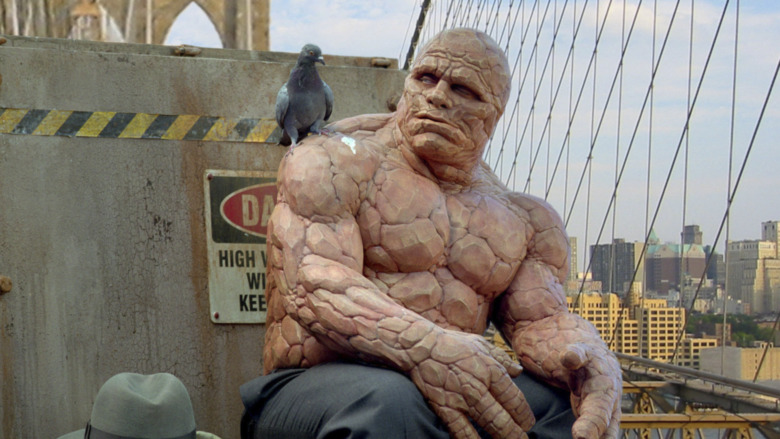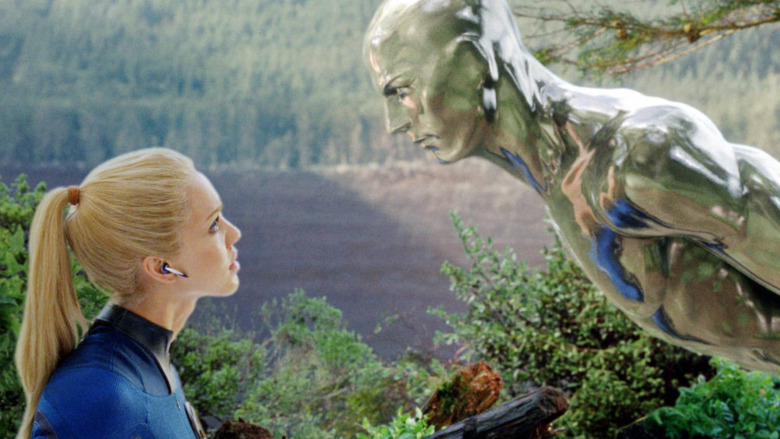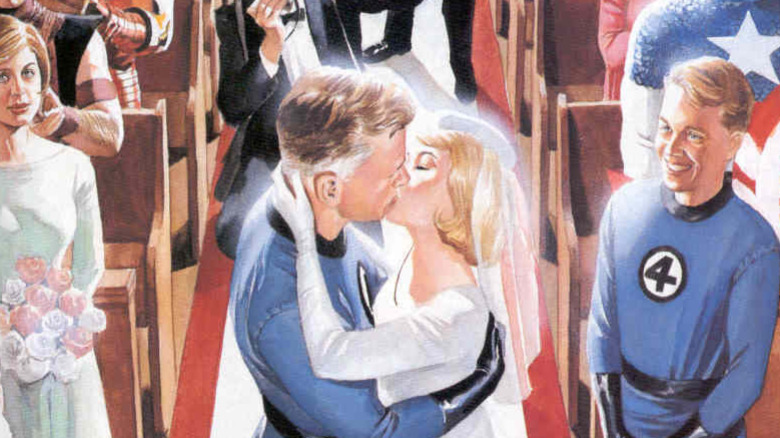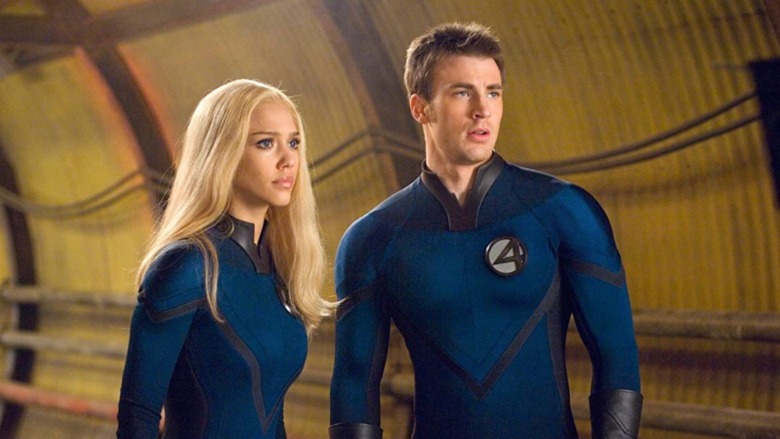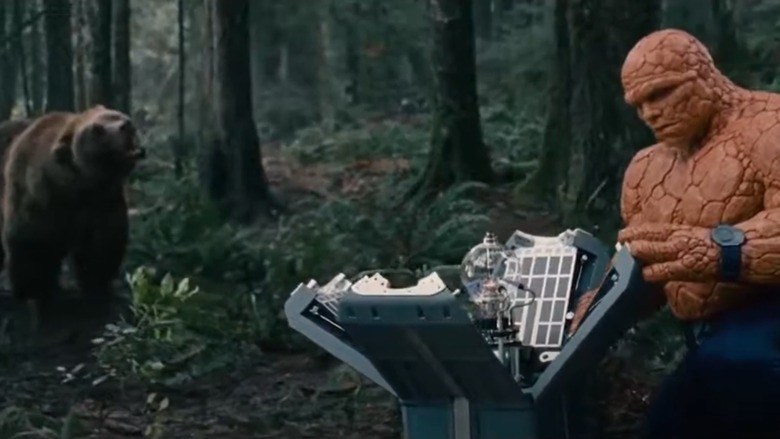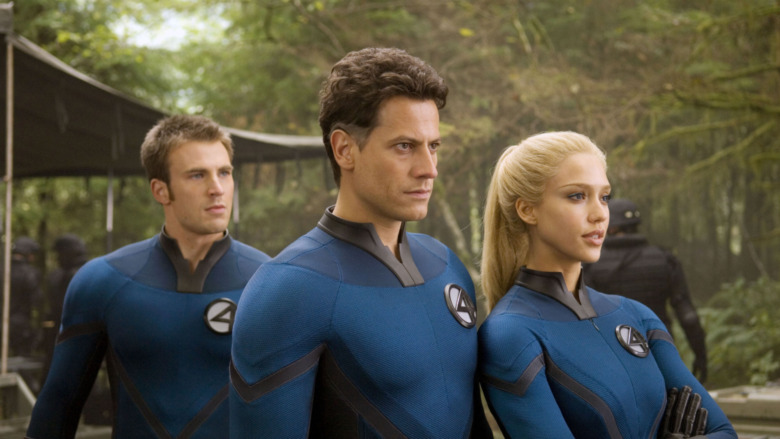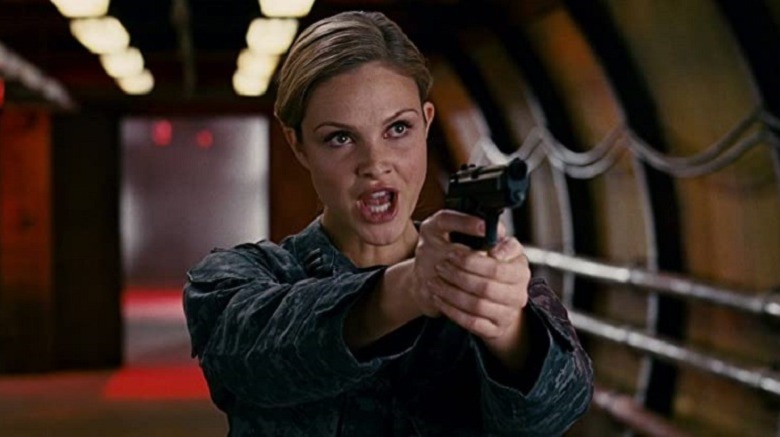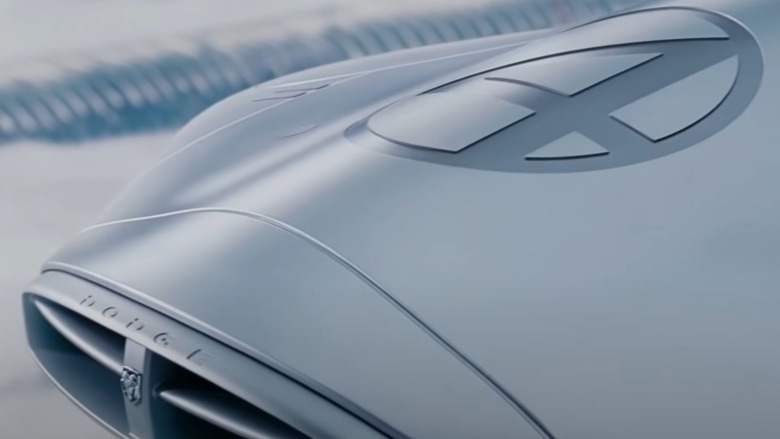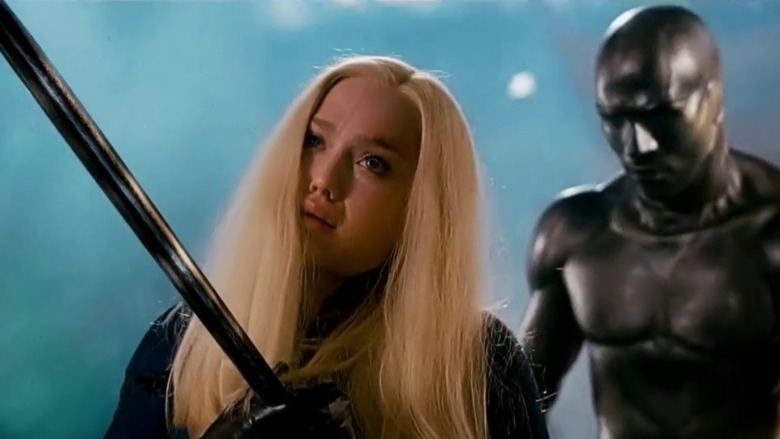Things Only Adults Notice In Fantastic Four: Rise Of The Silver Surfer
In 2007, the superhero movie landscape looked a lot different than it does today. It was the last year in film history without the Marvel Cinematic Universe, and the movies starring famous Marvel heroes all existed in their own individual universes, including "Fantastic Four: Rise of the Silver Surfer." The sequel to 2005's "Fantastic Four," this new installment brought back the original film's principal cast and the same director, Tim Story, for a new adventure. But while the faces were all familiar, this 2007 superhero flick introduced moviegoers to new, cosmic elements, including the titular Silver Surfer.
The result was ... mixed. With $289.4 million, the movie didn't make a massive splash at the worldwide box office, and both critics and audiences gave the film mixed marks. But even with these underwhelming results, there's still some interesting stuff to unpack from "Rise of the Silver Surfer," both good and bad. Chiefly, the feature delivers a number of moments that will soar right over the head of younger viewers. Some of these are attempts to tickle grown-up funny bones with sly double entendres, while others reflect sloppy storytelling choices that adolescent moviegoers won't fully grasp. In other words, adults will definitely notice that "Rise of the Silver Surfer" looks drastically different from the superhero movies of today.
Only adults get the meaning behind that rockslide joke
Whether it's in the movies or in the comics, Ben Grimm and Johnny Storm are always at each other's throats. For example, take the scene where their bickering sibling dynamic is reinforced by Storm giving Grimm a hard time about his love life. Specifically, Johnny uses vague hand gestures to inquire how exactly Grimm and Alicia Masters have sex. After Grimm tells him that it's none of his business, Storm notes that he was just asking out of concern. After all, Johnny explains, he just doesn't want to wake up one morning to hear news of Masters "being killed in a rockslide." Grimm responds by going into a rage and chasing Storm off-screen.
It's a gag meant to fly right over the heads of youngsters and inspire titters of giggles in adult viewers who will understand the sexual implications of Johnny's joke. However, the fact that it toes the line of discussing sexual intercourse so precariously does feel odd in a movie where the MPAA rating and storytelling are aimed at 6-year-olds. The joke being far from the height of wit also means it won't slay the adult viewers it's targeting. On many levels, this "rockslide" joke feels really out of place in such a corny comic book movie.
Silver Surfer is played by two different people
For younger viewers, it's easy to assume that the Silver Surfer was brought to life solely through his voice actor, with the physical character being a digital creation. But while it's true that the Silver Surfer is a CGI being, it turns out that two actors actually played the part, with one providing the voice and one providing the body.
Doug Jones, most famous for his work in Guillermo del Toro movies like "The Shape of Water" and "Hellboy," was the on-set stand-in and visual reference for the Silver Surfer. And initially, he was supposed to voice the character too, with some of his line readings even making it into early "Rise of the Silver Surfer" promotional materials. However, late in post-production, Laurence Fishburne was hired to dub over Jones. It's a process that mirrored what happened on the initial Hellboy movie in 2004, which saw Jones being dubbed over by David Hyde Pierce for the part of Abe Sapien.
It's also a process Jones had mixed feelings about. "This is a painful issue for me," Jones said to Rotten Tomatoes. "For any actor, it would be. No actor wants to see a portion of their performance taken away, myself included. ... A lot of people involved with the film told me that they got goose bumps and chills when I would talk as the Silver Surfer, so I am sorry to see that go."
Hey, who's that wedding minister?
During the wedding of Reed Richards and Sue Storm, a handful of famous faces can be seen, including close friends of the superhero team and even Stan Lee delivering his requisite cameo, this time as himself! And among the notable performers present is Brian Posehn as the priest officiating the wedding.
Though he won't be a familiar face to most adolescent viewers, Posehn's distinctive look and voice will immediately make him stand out to adult viewers. After all, his stand-up comedy and character actor work across film and television has made him a memorable figure in pop culture. His comedic talents in those fields are briefly utilized here in the ending of "Rise of the Silver Surfer," where Posehn's character reacts to the wedding between Richards and Storm getting postponed again.
Posehn has shown up in a number of projects older viewers will be able to recall, including his recurring roles on sitcoms like "The Big Bang Theory" and "New Girl," as well "Mr. Show," "The Sarah Silverman Program," "Steven Universe," and his one-episode appearance in "The Mandalorian." Among his other credits include a voiceover role in the feature film "Surf's Up," which was released the same month as "Fantastic Four: Rise of the Silver Surfer."
The idea of Reed and Sue's wedding goes back a long way
Romance and superhero movies often go together, so it was likely inevitable that Reed Richards and Sue Storm were destined to get married in a "Fantastic Four" movie. However, "Rise of the Silver Surfer" had extra incentive to go down this road considering that happy event had major precedence in some of the most iconic "Fantastic Four" comic books.
Younger viewers will likely be familiar with modern-day instances of marriage creeping into issues of "Fantastic Four," but only older viewers will know this wedding subplot dates all the way back to 1963. That's when the prospect of Reed and Sue getting married first emerged in the Marvel Comics Universe through "Fantastic Four Annual" #3. This particular issue saw the holy union between the two characters played against a grander cosmic adventures that involved countless corners of the Marvel Universe, paving the way for a critical and romantic plot point in "Rise of the Silver Surfer."
Rise of the Silver Surfer is the rare PG-rated live-action Marvel movie
When live-action Marvel movies really began to fire on all cylinders at the box office, it was with the R-rated Blade. That MPAA rating ensured this film would be aiming slightly older than the average adolescent age group that largely read Marvel Comics. Shortly afterwards, the PG-13 rated blockbusters X-Men and Spider-Man took Marvel's box office success to the next level. Since then, movies based on Marvel superheroes have become a go-to source for making stacks of cash. Just as enduring is that the majority of Marvel's live-action film adaptations have adhered to a PG-13 rating. This way, the films can appeal to a wide range of audience while still aiming a little older than the kid-oriented target demo of traditional mainstream comics.
However, there are two big exceptions to the PG-13 rule where the outcome wasn't R. One of these was "Howard the Duck," released during the nascent years of the PG-13 rating. The other was the more modern "Fantastic Four: Rise of the Silver Surfer." This 2007 title received a PG-rating for "sequences of action violence, some mild language and innuendo." It's unclear if this was an intentional move on the part of the filmmakers or just a puzzling incident reflecting how these particular superheroes have rarely (save for Josh Trank's 2015 reboot) embraced extreme darkness. Either way, this was a rare exception to Marvel's preference for PG-13 film adaptations.
The incongruity of a grizzly bear in Germany
In the middle of "Fantastic Four: Rise of the Silver Surfer," Ben Grimm has an unusual encounter. While setting up a machine in Germany's Black Forest, the superhero is approached by a grizzly bear. For a typical person, this would be the moment they meet a fate as grisly as the bear they've encountered. Of course, Ben Grimm — now that he's become the Thing — is not a typical person. Though the beast is initially ferocious towards Grimm, it isn't long before this rocky superhero unleashes a bellow that sends the bear scampering away. "Get lost, ya furball!" Grimm huffs as the bear leaves, concluding a scene meant to humorously show just how intimidating Grimm can be.
While kids will no doubt be giggling over this scene involving a big bear scampering away in fear, adults may have a totally different response. These viewers will realize that the scene is technically one of the most impossible sequences in "Rise of the Silver Surfer," a film featuring an alien hovering around on a surfboard. Grizzly bears are exclusively found in North America, including Vancouver, where the film was shot. They aren't found in Europe, let alone in Germany's Black Forest. Tragically, due to the activity of humans, bears are almost never found in Germany, and it's been that way since 1835. So perhaps this scene indicates that "Fantastic Four: Rise of the Silver Surfer" occupies a happier alternate reality where bears and humans managed to co-exist in Germany.
Keep an eye out for this Fantastic Four Easter Egg
"Fantastic Four: Rise of the Silver Surfer" ends with the main superheroes racing off from yet another wedding between Reed Richards and Sue Storm in their individual Fantasticar components. The quartet proceed to use their vehicles to create the number four in the sky before racing off to save the day. But this cutesy way of ending the movie isn't the first time that number has appeared on-screen in "Silver Surfer." Much as A113 crops up into every Pixar movie, so too does "Rise of the Silver Surfer" have its own Easter egg in the form of a hidden four.
The concealed nature of these numbers mean it'll take eagle-eyed adult viewers to notice one of the more clever appearances early in the story. Just over 30 minutes into the runtime, Johnny Storm ends his confrontation with the Silver Surfer by getting plopped into the Middle East. As he lands on the sandy surface below, you can spot the number four subtly ingrained into the ground. This doesn't factor into the plot, it's clearly just an Easter egg for moviegoers with particularly keen eyeballs.
In the comics, Frankie Reyes becomes a superhero
Beau Garrett's Frankie Raye doesn't have much of a substantial role to play in "Fantastic Four: Rise of the Silver Surfer." She's around to serve as a companion to General Hagar, and she vanishes once it's time for the Fantastic Four to go fight Galactus and Doctor Doom. However, adults with knowledge of older comic books will likely remember that Raye does have a much larger role in Fantastic Four lore.
In the comics, Raye spark up a romance with Johnny Storm, something the movie hints at by having the two constantly talking with one another. But more importantly, Raye was her own superhero known as Nova. She began her crime-fighting life as basically a female-version of the Human Torch before taking on cosmic superpowers that allowed her to establish her own distinct identity. Nova went on to appear in a number of other comic book storylines and even found her way into a handful of animated programs based on the world of Marvel Comics.
Considering that "Rise of the Silver Surfer" introduced cosmic elements of Fantastic Four lore into the short-lived franchise, perhaps there were plans to eventually turn Frankie Raye into Nova. Tragically, the disappointing box office of "Silver Surfer" ensured fans would never get to see this incarnation of Raye become anything more than a disposable background character for Johnny Storm to ogle.
Check out the product placement on the Fantasticar
Once it's time for the Fantastic Four to go confront Galactus, they head out in a mode of transportation familiar to anyone whose read their exploits in the comics. That's right — it's time for the Fantasticar to make its debut in the live-action movies. Like its comic book counterpart, this vehicle can fly through the air, go at super fast speeds, and split up into three sections. It's a handy vehicle to have around when you need to get to places in distress fast, especially since Johnny Storm is the only member of the team who can actually fly by himself.
One key difference between the comic and film versions of this car, though, is that "Fantastic Four: Rise of the Silver Surfer" opts to use this vehicle as a moment for product placement. Upon seeing that the car has a Dodge logo on it, Johnny Storm asks Reed Richards if it's "a Hemi" (a reference to the engine), and Richards responds in the affirmative. While meant to be a moment of levity, it's an awkwardly incorporated moment since it undercuts the characters' awe at seeing the Fantasticar. Worse, adults will pick up on how this movie aimed at children just paused its runtime to have superheroes promote Dodge automobiles. That's a super example of corporate synergy but not super great to see in a movie for youngsters.
Sue Storm doesn't do much in the film's climax
If you're a child, the climax of "Fantastic Four: Rise of the Silver Surfer" likely registers as just a lot of wham-bam-noise. Doctor Doom gets hit with a crane, superpowers get switched around, and Silver Surfer sacrifices himself to stop Galactus. In other words, a lot of large-scale mayhem happens at a frantic pace. As a result, even adult viewers may not initially catch on one disturbing detail concerning how one of the film's four leads, Sue Storm, has nothing to do in the finale except temporarily die.
During the climax, Doom throws a spear that impales Sue Storm, killing the superhero. It's a puzzling development from the get-go since the spear penetrates her superpowered shields. Shouldn't her abilities innately be able to deflect such objects? Things get worse when she lies in a comatose state for the rest of the sequence so that Silver Surfer can be reminded of his one true love and be inspired to sacrifice himself. Despite being one of the four leads of this movie, Sue Storm's only real role in this climax is to die. The moment sums up the shabby treatment the character received during both live-action "Fantastic Four" movies.
